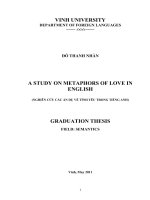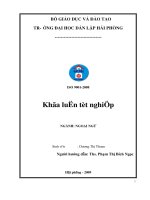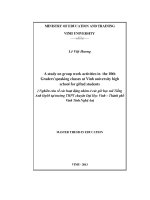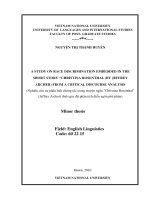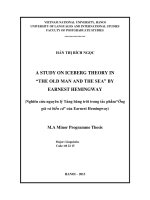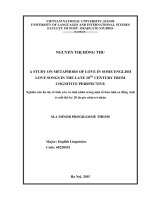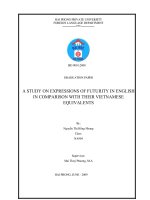A study on metaphors of love in english songs in the late 20th century from cognitive perspective
Bạn đang xem bản rút gọn của tài liệu. Xem và tải ngay bản đầy đủ của tài liệu tại đây (782.5 KB, 61 trang )
VIETNAM NATIONAL UNIVERSITY, HANOI
UNIVERSITY OF LANGUAGES AND INTERNATIONAL STUDIES
FACULTY OF POST- GRADUATE STUDIES
-----------o0o------------
NGUYỄN THỊ HỒNG THU
A STUDY ON METAPHORS OF LOVE IN SOME ENGLISH
LOVE SONGS IN THE LATE 20TH CENTURY FROM
COGNITIVE PERSPECTIVE
Nghiên cứu ẩn dụ về tình yêu và tình nhân trong một số bản tình ca tiếng Anh
ở cuối thế kỷ 20 từ góc nhìn tri nhận
M.A MINOR PROGRAMME THESIS
Major: English Linguistics
Code: 60220201
Ha Noi, 2015
VIETNAM NATIONAL UNIVERSITY, HANOI
UNIVERSITY OF LANGUAGES AND INTERNATIONAL STUDIES
FACULTY OF POST- GRADUATE STUDIES
-----------o0o------------
NGUYỄN THỊ HỒNG THU
A STUDY ON METAPHORS OF LOVE IN SOME ENGLISH
LOVE SONGS IN THE LATE 20TH CENTURY FROM
COGNITIVE PERSPECTIVE
Nghiên cứu ẩn dụ về tình yêu và tình nhân trong một số bản tình ca tiếng Anh
ở cuối thế kỷ 20 từ góc nhìn tri nhận
M.A MINOR PROGRAMME THESIS
Major: English Linguistics
Code: 60220201
Supervisors: Associate Professor Võ Đa ̣i Quang, Ph.D
Ha Noi, 2015
DECLARATION
I certify that this thesis A study on metaphors of love in some
English love songs in the late 20th century from the cognitive perspective
is the result of my own research and the substance of this thesis has not
been submitted for a degree to any other university or institution.
The work was done under the guidance of Assoc. Prof. Dr. Võ
Đại Quang, my supervisor.
Ha Noi, November 2015
Nguyen Thi Hong Thu
i
ACKNOWLEDGEMENTS
I would like to take this opportunity to thank all the following people for
their great supports during my two-year time for the MA course.
First and foremost, I would like to express my deep gratitude to Assoc. Prof.
Dr. Võ Đại Quang, my supervisor, for his clear guidance, insightful comments and
dutiful supervision.
My deep thanks also go to all the lecturers at University of Languages and
International Studies, Vietnam National University- Ha Noi for their knowledge,
experience and enthusiasm in their lectures, from which I have acquired valuable
knowledge and inspiration to fulfill this minor thesis.
With the passion for literature and semantics, I am really interested in the
lectures of Prof. Dr. Nguyen Hoa and Assoc. Prof. Dr. Nguyen Thom which have
inspired me to do this study.
I also would like to express my sincere thanks to my family any many of my
friends and colleagues for their valuable sharing and encouragements.
Finally, my sincere thanks are for the people who will give me the precious
comments after reading the graduation thesis.
ii
ABSTRACT
In this thesis, the researcher has tried to give an overview of the relevant
literature review in the concern of the knowledge related to metaphors basing on
the theory of the famous writers, especially Lakoff and Kovecses. This study
focuses on the metaphors of love and lovers in the English love songs in the late
20th century from the cognitive perspective. It will help the readers have a deeper
sight into theoretical knowledge on metaphors in order to be able to find out,
comprehend and analyze the interesting metaphors in songs. The writer also
suggests some suitable ways for learners to learn English better, for teachers to give
the effective lectures and for readers to translate the texts more exactly.
In the paper, the researcher introduces, analyzes 86 quotes from 68 songs in 16
basic sets of metaphors: "Love is a natural phenomenon," "Love is Game", "Love is
war "," Love is music "," Love is the light "," Love is the concrete objects, "" Love is
madness "," Love is abstract things " "Love is closeness", "Love is heaven", "Love is a
religion", "Love is a journey", "Love is living creature", "Love is magic", and "Love is
fire", "Love is high/deep". The researcher clarifies the metaphorical images of love in
songs, analyzes and categorizes them into 3 subtypes: ontological, structural or
orientational metaphors with 16 sets of metaphors. Then, the writer introduces and
explains the ways how these metaphors are used as well as their artistic value in these
songs.
iii
TABLE OF CONTENTS
DECLARATION ........................................................................................................ i
ACKNOWLEDGEMENTS ....................................................................................... ii
ABSTRACT .............................................................................................................. iii
PART A. INTRODUCTION ....................................................................................1
1. Rationale of the study..............................................................................................1
2. Aims and objectives of the study ............................................................................1
3. Significance of the study .........................................................................................2
4. Scope of the study ...................................................................................................2
5. Method of the study .................................................................................................3
6. Organization of study ..............................................................................................3
PART B: DEVELOPMENT.....................................................................................4
CHAPTER 1: LITERATURE REVIEW ................................................................4
1.1. Review of theoretical background ....................................................................4
1.1.1. Word and its meanings .................................................................................4
1.1.2. Change of meaning. ......................................................................................5
1.1.3. Components of Word Meaning ....................................................................5
1.1.4. Concepts of metaphor ................................. Error! Bookmark not defined.
1.1.5. Classification of metaphor ............................................................................7
1.1.6. Conceptual (cognitive) metaphors ................................................................7
1.1.7. Classification of conceptual (cognitive) metaphors ......................................8
1.1.8. Target domain and source domain of conceptual metaphor ..........................9
1.2. Review of previous works related to the theme of the thesis. ......................10
1.2.1. ―Metaphor we live by‖ (1980) by Lakoff and Johnson ..............................10
1.2.2. ―A holographic study of metaphors concerning love in Chinese‖ by
Renying Yang .......................................................................................................10
1.2.3. Richard Nordquist on his article ―Love is metaphor". ...............................10
1.3. Summary ...........................................................................................................11
CHAPTER 2: RESEARCH METHODOLOGY .................................................12
iv
2.1. Research-governing orientations ....................................................................12
2.1.1. Research questions ......................................................................................12
2.1.2. Research types ............................................................................................12
2.1.3. Research approach ......................................................................................12
2.1.4. Research methods .......................................................................................13
2.2. Data collection and data analysis ....................................................................14
2.2.1. Data .............................................................................................................14
2.2.2. Data collections instruments .......................................................................14
2.2.3. Data analysis techniques .............................................................................14
2.2.4. Data analysis ...............................................................................................15
2.3. Research procedures .......................................................................................15
2.4. Reliability and validity .....................................................................................16
2.5. Summary ...........................................................................................................16
CHAPTER 3: FINDINGS AND DISCUSSION ...................................................17
3.1. The typical metaphorical images of love and lovers in love songs in the
late 20th century from cognitive perspective ........................................................17
3.1.1. Ontological metaphors ................................................................................17
3.1.1.1. Love is a concrete and real object .......................................................17
3.1.1.2. Love is a living creature ......................................................................20
3.1.1.3. Love is a natural phenomenon. ...........................................................21
3.1.1.4. Love is a game .....................................................................................22
3.1.2. Structural metaphors ...................................................................................23
3.1.2.1. Love is light .........................................................................................24
3.1.2.2. Love is madness ..................................................................................24
3.1.2.3. Love is the abstract thing.....................................................................25
3.1.2.4. Love is religion ....................................................................................27
3.1.2.5. Love is closeness .................................................................................28
3.1.2.6. Love is magic ......................................................................................31
3.1.2.7. Love is music .......................................................................................32
v
3.1.2.8. Love is a journey .................................................................................33
3.1.2.9. Love is the heaven ...............................................................................34
3.1.2.10. Love is fire.........................................................................................34
3.1.2.11. Love is a war .....................................................................................36
3.1.2. Orientational metaphors ..............................................................................37
3.2. How these metaphorical images are expressed in songs. ..............................38
3.3. The artistic value of the metaphorical images in songs ................................39
3.4. Discussion of findings. ......................................................................................39
3.4.1. Occurrence of linguistic items used metaphorically in songs. ...................39
3.4.2. Occurrence of love metaphors in English songs in three subtypes. ..................41
3.5. Summary ..........................................................................................................42
PART C: CONCLUSION.......................................................................................43
1. Concluding remarks and Implications ..............................................................43
1.1. Concluding remarks .......................................................................................43
1.1.1. The typical metaphorical images of love and lovers in English songs ..43
1.1.2. How these metaphorical images are expressed in songs. .......................43
1.1.3. The value of these metaphorical images in songs Error! Bookmark not
defined.
1.2. Implications ..................................................................................................43
1.2.1. Implications for learners .......................................................................44
1.2.2. Implications for teachers ........................................................................45
1.2.3. Implications for translators ...................................................................46
2. Limitations and suggestions for further studies ...............................................47
REFERENCES ........................................................................................................ 49
vi
PART A. INTRODUCTION
1. Rationale of the study
Metaphor in language is like a flower of life. Life becomes more beautiful with the
colorful flowers and language becomes more legend and lovely with the
metaphorical images. Understanding metaphors is crucial to comprehend figurative
language in literature and to enhance practicing skills of learning English.
Metaphors are used to describe something that the author cannot adequately
represent in a literal fashion or in a simple declarative sentence. They can broaden
or bring a fresh perspective to a familiar or overused subject. Writers use metaphors
to give clarity to their writing or to paint a visual picture by words. Whatever the
author's intent, analyzing the context in which metaphors are used will reveal much
about the poem's or prose work's meaning. Adding metaphors when writing stories,
poems or songs means adding interest and depth to writing. Metaphors create more
specific and clearer visual images of what the writer is trying to express.
Metaphors, which are traditionally believed to be associated with literary or poetic
language, are an ideal new land in music world for musicians and the language
learners. It is an effective device to make the communication more lively and
colorful.
By teaching students how to understand metaphors, we can lead them unleash their
creativity and imagination. Metaphors can also be effective in training learners in
abstract thought as well as familiarizing them early with literary skills they will
need later in their education.
Love is a beautiful song in life. People in love create the unique words to give the
lovely messengers to each other and with the power of metaphor, love becomes the
wings in sky. Metaphors are wonderful device for musicians to write the love songs.
Through the love songs, metaphor is understood and studied more interestingly and
effectively.
2. Aims and objectives of the study
2.1. Aims of the study
This paper is to investigate metaphorical images of love and lovers used in English songs
1
in the late 20th century from the cognitive perspective. It will help the readers:
- Have a deeper sight into theoretical knowledge on metaphor in order to be able to
find, comprehend and analyze the interesting metaphors in songs.
- Create some suitable ways for learners to learn English better, for teachers to give
the effective lectures and for readers to translate the texts more exactly.
2.2. Objectives of the study
In order to achieve the aims of the study, the objectives will be elaborated into the
following research questions:
1. What are the typical metaphors of love in English love songs in the late 20th
century from the cognitive perspective?
2. How are the metaphors of love expressed in the love songs?
3. Significance of the study
3.1. Theoretical significance
This study is to find out typical metaphorical images of love and lovers in the
famous English love songs with a view to contributing to the studies of linguistics
from cognitive prospective. That how these metaphorical images are expressed in
cognition and the artistic value of these images in songs will be analyzed
specifically can provide a new look into English literature.
3.2. Practical significance
This research is performed with the purpose of helping Vietnamese learners and
teacher of English better understand conceptual metaphors in English songs and
then create the suitable tips to apply language flexibly. As a result, they will be
able to learn and teach English effectively. In addition, it can contribute to the
teaching of literature, semantics, cultural linguistics applied in Vietnamese
universities of foreign languages. Especially, the translators will take the
necessary notes when working with metaphors in the process of translation
4. Scope of the study
Basing on the theory of the famous writers, especially Lakoff and Kovecses, this
study focuses on the metaphors of love and lovers in the famous English love songs
2
in the late 20th century from the cognitive perspective.
5. Method of the study
The study is mainly carried out through the documentary analysis and descriptive
study with the support of qualitative and quantitative approach. The data is
quantitatively analyzed in terms of the percentage of the occurrence of metaphorical
images in all the songs to see the preference for which sets of expressions as well as
frequencies of three types of metaphors: structural, ontological, and orientational.
Through qualitative approach, the metaphors, after being divided into categories
according to the procedure of transferring meaning from the vehicles to the tenors
guided by a theoretical lens, will be analyzed in details, synthesized and evaluated.
6. Organization of the study
This study includes three parts and 3 chapters:
Part A: Introduction
Part B: Content
Chapter 1: Literature review
Chapter 2: Methodology
Chapter 3: Findings and Discussion
Part C: Conclusion
3
PART B: DEVELOPMENT
CHAPTER 1: LITERATURE REVIEW
1.1. Review of theoretical background
1.1.1. Word and its meanings
It is obvious that language is a tool for expressing human thought. It reflects the
way people think and view the world around them. Each language has a different
characteristic but it is generally expressed through a simply meaning form of
language: word.
In linguistics, a word is the smallest element that may be uttered in isolation
with semantic or pragmatic content. In ―Understanding English Semantics‖ by
Nguyen Hoa (2004: 67) the word is regarded as the smallest indivisible meaningful
units of a language which can operate independently. The new point of this definition
is that it clarifies the independent characteristic of the word as a language unit.
Jackson & Amvela (2000: 50) mention the word as an uninterruptible unit of
structure consisting of one or more morphemes and which typically occurs in the
structure of phrases. Hoang Tat Truong has an investigation in the independent
characteristic of words in Basic English Lexicology (1993:2) in which the word is
defined as dialectical unity of form and content, independent unit of language capable
to form a sentence by itself. It can be seen from the definitions of the author that the
word is the meaningful smallest unit that consists of the form and the content. Words
are divided into two basic types: Lexical words and grammatical words.
The meaning of any word is a matter of what we do with our language, not
something hidden inside anyone's mind or brain so Patrick Hogan (2010: 42)
takes another definition ―Word meaning relates to the semantic value‖ that is
conventionally associated with individual lexical items, which is to say word.
Because this paper partly depends on senses of words and semantic change to
discover the metaphorical concepts of love, the following part is to focus on
change of word meaning.
4
1.1.2. Change of meaning.
Language is a thing that is just changing all the time. The change can affect any part
of language such as sounds, pronouncing, words combination...According to
Bloomfield, Leonard (1933: 425) ―innovation which change the lexical meaning
rather than the grammatical function of a form, are classed as change of meaning or
semantic change‖. The definition emphasizes lexical meaning change, whatever
structure types the word belongs to. Trier (1931: 134) with the studies beyond the
analysis of single words has claimed that every semantic change of a word would
affect all other words in lexical term.
All words have a meaning, but since English first appeared from its base language,
the meanings of words have undergone changes. Semantic change is the evolution
of word usage — usually to the point that the modern meaning is radically different
from the original usage. It is a change in one of the meanings of a word. Every word
has a variety of senses and connotations, which can be added, removed, or altered
over time, often to the extent that cognates across space and time have very
different meanings.
An example of semantic change is metaphor as stated by Bloomfield,
Leonard (1933), ―Poetic metaphor is largely an outgrowth of transferred uses of
ordinary speech‖. Metaphor is a semantic change based on the association of
similarity between referents. The basic structure of the metaphor is very simple.
There is a thing we are talking about and that to which we are comparing it.
Love is just a game, broken all the same (The Magic Numbers - Love Is Just a Game)
This quotation expresses a metaphor because the love is not literally a game. By
figuratively asserting that the Love is just a game, the writer uses the points of
comparison between the love and a game to convey an understanding about the
characteristic of the love as a game – false and temporary.
1.1.3. Components of Word Meaning
According to John Lyon (1996: 437), there are four major components of word
meaning:
5
(a). Denotation: It includes conceptual and referential meanings which exist by
virtue of what it refers to.
(b). Connotation: It includes stylistic, affective, evaluative, and intensifying
meaning that is the pragmatic communicative value of the words.
(c). Structural meaning: is the meaning of a word acquires by virtue of its
membership in a system or a set.
(d). Categorical meaning: is the meaning which serves as a classificatory basis.
In Understanding English Semantics, Nguyen Hoa (2004: 98) refers to denotation as
the ability of a word or expression to identify all the objects covered by a word.
While connotation is the communicative value of a word or an expression by virtue
of what it refers to, over and above its purely conceptual content.
If semantics components serve as material to analyze metaphors
1.1.4. Concepts of metaphor
Language is a very powerful tool as it reflects the way we categorize and
conceptualize the world we live in. It is almost impossible to understand a thing
without grouping it with other category members that share the same properties. In
doing so, we acquire different kinds of concepts and, as a result, build our general
knowledge. Metaphors supply these requirements. Often we treat them only as
stylistic devices, but in fact metaphorical expressions verbally represent the way of
human thinking and reasoning. People tend to conceptualize emotions, love being
one of them, metaphorically because both emotions and metaphors connected with
them are inevitable parts of everyday live.
''Without our ability to categorize, we would not function at all, either in the
physical world or in our social and intellectual lives'' (1990: 6) Lakoff explains. So
many definitions of metaphor are created but it can be understood in the most
common way: According to Lakoff and Johnson (1980: 4), ―Metaphor is for most
people a device of the poetic imagination and the rhetorical flourish - a matter of
extraordinary language rather than ordinary language‖. A metaphor can be defined
in
the
other
ways
an object or concept it
for
does
―The application of
instance,
not
literally
6
denote,
a word or phrase to
suggesting comparison to
that object or concept‖. (Baars. B.J, 1998:4). It is clear that the term metaphor refers
to the meaning of the word that can be expanded beyond its literal meaning. For
example, "a sea of troubles" or "All the world's a stage" (Shakespeare)
As it is stated by Vo Dai Quang (2005:169), metaphor is word meaning transference
based on similarity between two things as regards function, character, size, shape,
age, color etc. Having the same idea, Trần Văn Cơ (2011: 4) confirmed that
metaphor is meaning transference. These definitions give the readers the insight into
the metaphorical nature of the concepts that structure our everyday activities.
Metaphor is one kind of comparisons. It is the name given to a way of using
language in a way that relies more on imagination than literal reality. For examples:
―Love is a rose‖,In this example, the word rose has a connotative meaning that is
thought to be a very beautiful and fresh object to people. The essence of love is likened
and understood in terms of a characteristic of a rose. So, this meaning is transferred to
refer to the characteristic of love to imply that love is lovely and wonderful.
1.1.5. Classification of metaphor
There are many ways to classify the metaphor. According to Lakoff and Johnson,
three types of metaphoric concepts can be distinguished, marginal metaphoric
concepts ( Lakoff and Johnson 1980: 55), conventional metaphoric concepts (Lakoff
and Johnson 1980: 4), and new metaphoric concepts (Lakoff and Johnson 1980:
145). Metaphoric concepts take public form in metaphoric expressions, also called
―metaphors‖. Metaphors, like any other stylistic devices, can be classified according
to their degree of unexpectedness. As it is stated by Nguyen Hoa (2004: 109), basing
on the degree of unexpectedness, there are three main types of metaphors namely
living metaphors, faded metaphors and dead metaphors
1.1.6. Conceptual (cognitive) metaphors
George Lakoff and Mark Johnson claimed that metaphor is not just a matter of
language, but a matter of thought (1980: 7). They believe that language is an
indicator of the nature of our conceptual system, and metaphor is so pervasive in
language that it actually structures how we make sense of and interact with the world
around us. Hence the term ‗conceptual metaphor‘ appeared.
Metaphor is a way of understanding a concept and according to Lakoff and Johnson,
7
meaning and truth depend on understanding. Truth is not objective, but depends on
context; it relies on a human thinker. Thus, metaphors structure what we perceive as
truth. Kövecses believes that metaphor involves using one conceptual domain to
understand another conceptual domain (Kövecses, 2002:4).
Cognitive Linguistics allows us to understand that metaphorical thinking is crucial to
human cognition. Thus, Lakoff and Johnson propose a cognitive theory of metaphor,
as a process thanks to which one concept is understood using another concept
(Lakoff 1980: 5). The best example of this is talking about love in terms of journey.
As mentioned previously, our ability to categorize allowed us to gather knowledge
about journeys that we can depend on in understanding love. Kövecses emphasizes
that we need to differentiate conceptual metaphor from metaphorical linguistic
expressions. He proves that the latter disclose the existence of the former. ―To know
a conceptual metaphor is to know this set of mappings A is B. It was also pointed
that metaphor in cognitive linguistic view is primarily conceptual metaphor.
1.1.7. Classification of conceptual (cognitive) metaphors
According to Lakoff and Johnson in Metaphors We Live By (1980) and Zoltan
Kovecses in Metaphor: A Practical Introduction, there are 3 kinds of conceptual
metaphors: structural metaphors, orientational metaphors, ontological metaphors.
a. Structural metaphors:
Structural metaphors are generally understood conceptual metaphors where one
concept is metaphorically structured in terms of another. Structural metaphor is the
most productive type of all conceptual metaphors. ‗Structural metaphors‘ occur
when a concept is metaphorically structured by another concept ‖, as Lakoff and
Johnson (1980: 61) write, e.g. Love is a journey. In Metaphors we live by Lakoff
and Johnson state that 'the conceptual system is metaphorical in nature' (Lakoff,
1980:4).
b. Orientational metaphors:
Orientational metaphors organize immaterial concepts in terms of physical
orientation: happiness is up (high spirits) and sadness is down (feeling low), the
future is ahead and the past behind. The group of orientational metaphors is said to
be connected with our orientation in space (Lakoff, 1980:16).
8
c. Ontological metaphors:
In ontological metaphors experiences are treated as concrete objects e.g. containers
(I put a lot of energy into preparing decorations). When we deal with them in such a
way we can "refer to them, categorize them, group them, and quantify them - and, by
these means, reason about them" (Lakoff, 1980:25).
LOVE IS FIRE metaphor is an example for structural metaphor.
―My heart is on fire, I do not want to get burned again, that kindled love in his heart.‖
Thanks to the metaphorical expression that kindled love in his heart, we can
conceptualize love as having a beginning and an end just as fire has. When the fire is
kindled, the love begins; when it goes out, the love ends. These examples also prove
that we not only talk about love in terms of fire. The lover can be consumed by love
when he/she is so in love that it is all that he/she thinks about. If the lover does not
want to get burned again it may mean he/she does not want to experience the same
serious disappointment after an unsuccessful relationship.
1.1.8. Target domain and source domain of conceptual metaphor
Conceptualist views consider metaphor as a cognitive mechanism used to structure
our knowledge in the mind by means of one domain of experience understood in
terms of the first one
A metaphor has two conceptual domains. One is the thing that is to be understood,
which is called the target domain, and the other is the thing that is used to
understand the first one, and it is called the source domain (Kövecses, 2002:4). The
source domain and the target domain interact in ―a set of systematic
correspondences between the source and the target‖ which ―are often referred to as
mappings‖ (Kövecses, 2002:6).
According to Barcelona (2000:3), Metaphor isthe cognitive mechanism whereby one
experiential domain is partially mapped or projected onto a different experiential
domain so that the second domain is partially understood in terms of the first one. In
the example ―love is a game‖, "love" is compared to a game, describing it with the
attributes of "game"; "love" is the tenor, and "a game" is the vehicle.
9
1.2. Review of previous works related to the theme of the thesis
Up to now, there have been various studies on the metaphor based on theories of
linguistic scholars such as:
1.2.1. “Metaphor we live by” (1980) by Lakoff and Johnson
Lakoff and Johnson are the most remarkable writers with the famous books on
metaphor that introduce the overview and deep knowledge on metaphor. Of all,
―Metaphor we live by‖ (1980) is most helpful and worth for the researcher to take
as a basic theoretical background for their thesis. The book has a great influence on
our understanding of metaphor and its role in language and the mind. The authors
supply an afterword surveying how their theory of metaphor has developed within
the cognitive sciences to become central to the contemporary understanding of how
we think and how we express our thoughts in language. Lakoff and Johnson launch
into a stimulating deconstruction of what they term "conceptual metaphors", and the
complex way in which they interact to structure our experience of reality.
Lakoff sets out to show that metaphors are a fundamental part of our thought
processes whenever we try to think abstractly. His book does not provide a rigorous
scientific proof, but it does present a lot of evidence in favor of the thesis.
1.2.2. “A holographic study of metaphors concerning love in Chinese” by
Renying Yang
This work makes a thorough analysis of love metaphors in Chinese. Based the
conceptual study of emotional metaphors by Lakoff, Kovecses and the others, this
paper structures a conceptual metaphor of love in Chinese and reveals an
understanding of its characteristics and cultural models. It also presents the culturalspecific characteristics by giving a diachronic study of love metaphors in Chinese.
1.2.3. Richard Nordquist on his article “Love is metaphor".
The writer lists 99 metaphors of love in many literature works. These metaphors
come from the real and concrete things in our life such as rose, star, journey, flame,
razor…However, this is only the examples of love metaphors. The readers expect to
have a more specific interpretation on these kinds of metaphors basing on the
theoretical background.
10
In short, these works play an important role in building language instructions in
general and instructions for use of metaphors in particular. However, up to now, not
many studies base on the cognitive perspective to analyze the metaphors of love in
songs deeply and systematically. Also, the number of metaphors of love quoted are
not diverse and various. In addition, these have little authentic and practical value in
teaching and translation. It is the reason why I have decided to do the research
entitled ―A study on love and lovers in some English songs in the late 20th century
from the cognitive perspective‖ with the hope to give the reader the interesting
experience through the metaphoric images in songs as well as their artistic value
and from this analysis to make a meaningful contribution to learning English in
reading and writing skills for learners, teachers and translators.
1.3. Summary
To sum up, in this chapter, the researcher has tried to give an overview of the
relevant literature in the concern of the study. It has dealt with the knowledge
related to metaphors such as word, word meaning, meaning transference as well as
detailed description about metaphors introduced such as definitions of metaphor,
cognitive metaphor, types, mapping. Furthermore, the chapter helps the readers
understand more profoundly and typically about metaphors – a very important
knowledge to learn, teach, translate and study.
11
CHAPTER 2: RESEARCH METHODOLOGY
2.1. Research-governing orientations
With the aim of achieving the study on linguistic features and the distinctive
features of metaphors as well as interpreting the metaphorical images of love and
lover in songs, the thesis is carried out through the documentary analysis method
combined with the descriptive, qualitative and quantitative approaches. Besides,
inductive analytic method and description are also used in this research.
2.1.1. Research questions
1. What are the typical metaphors of love and lovers in English love songsin the late
20th century from the cognitive perspective?
2. How are the metaphors of love expressed in the love songs?
2.1.2. Research types
This thesis is carried out based on the basic research type. This type of research
advances fundamental knowledge about metaphors in order to give the new findings
for scientific research. It involves the creation of a theoretical system of analysis
based on the observation and careful study of mostly published works like
researching through archieves of public libraries, internet and published academic
journals about metaphor such as the famous works ― Metaphor we live by ‖by
Lakoff and Johnson (1980), Metaphor: A Practical Introduction by Zoltan
Kovecses (2002), Understanding English Semantics by Nguyen Hoa (2004), ect.
The study is a means of discovering new meaning of love and lover, describing
what exists in the world of emotion on the basis of the data on metaphors that have
been collected through songs. Research papers allow the writer to take their new
thoughts thanks to the knowledge acquired through previous works to be applied
toward her own topic of choice ―A study on metaphors of ―love‖ and ―lovers‖
English love songs‖. The research also includes the personal knowledge, intellectual
application in the investigation of the topic.
2.1.3. Research approach
This study is mainly carried out according to qualitative and quantitative
12
approach. However, qualitative method is dominantly used. Quantitative
research is based on analyzing the data, measuring with numbers, and using
statistical techniques to find out the percentage of metaphorical systems
occurring in the songs collected. By contrast, qualitative research involves an
interpretive and naturalistic approach: researcher studies metaphors in their
natural settings, attempts to make sense of, to interpret, phenomena in terms of
the meanings such as love is fire, love is a game, ect.
Mixed methods research is an approach to inquiry involving collecting both quantitative
and qualitative data, integrating the two forms of data, and using distinct designs that
may involve philosophical assumptions and theoretical frameworks.
The research based on qualitative approach tends to be inductive. This involves a move
from the specific to the general and is sometimes called a bottom-up approach in which
a theory is looked for and developed on the basis of the data that collected. From
analyzing the samples or quotes from many love songs guided by a theoretical lens
which provides a framework for the investigation, the last result, 16 settings of love
metaphor are referred and categorized.
2.1.4. Research methods
The major methods which are used for this thesis are documentary analysis and
descriptive research methods. Documentary analysis is a form of qualitative
research in which documents are interpreted by the researcher. It refers to the
various procedures: First of all, official documents related to metaphor are
collected. The task for the researcher is not to take such documents at face value. In
addition to finding out the vital theoretical knowledge on metaphors, the researcher
must realize where the metaphorical images used are in songs, what terms they
belong to, how they were constructed, and how they are used and interpreted. After
analyzing and interpreting data generated from the examination of documents and
records, the findings will be categorized and synthesized. Descriptive research will
provide an accurate portrayal of characteristics of metaphor and typical
metaphorical images of love and lovers in English songs basing on theoretical
13
framework.
2.2. Data collection and data analysis
2.2.1. Data
The data for analysis are mainly samples taken from the famous English love songs
of all kinds in the late 20th century. There are 68 songs used with 86 sentences
quoted. They almost come from the collections of Carpenter, Beatles, Holly
Knight, Blink, Amy Wine house ect. They are collected from websites, newspapers,
magazines, books… In this way, the natural and practical manner of the material
will reinforce the accuracy of the results. The major method to collect data is
surveying with observation of instances of linguistic expressions used to signal
metaphor, selecting the samples related to the topic.
2.2.2. Data collections instruments
Reading, reviewing and selecting documentary are considered as the main
instruments for collecting data that is collected in textual form on the basis of
observation of previous works, songs and references related. The author read any and
all kinds of documentation related to metaphors used to provide useful information.
To gather the various and valuable data, the author had to listen to any songs she
heard by chance anywhere and write down all the sentences related metaphor, then
categorize them according to the criteria such as time published, types and choose the
ones suitable for the topic. After the process of researching and collecting data, the
information continues to be classified into different categories depending on the
requirements of the research in order to make it easy for the researcher to find and to
analyze the data.
2.2.3. Data analysis techniques
After the process of reading and collecting data from the songs found, the
researcher starts to analyze the image of love in terms of conceptual metaphor.
From numerous samples, the researcher tries to choose the most interesting and
concrete ones to illustrate important points under the investigation. The next step is
to synthesize the information analyzed in order to fit into the thesis. The stage of
14
analyzing and synthesizing are all conducted manually. By analyzing and
synthesizing, the researcher hopes to be on the right way of mapping out the images
of love in songs
2.2.4. Data analysis
All the samples are categorized and described, then qualitatively and quantitatively
processed. In order to achieve the aims of this study, both quantitative and
qualitative methods are adopted for data analysis. The data is qualitatively analyzed
and in 16 sets of expressions denoting love according to conceptual metaphor
theory, Lakoff & Johnson (1980) and Kovecses (1986): love is conceptualized as
natural phenomena, games, war, music, light, concrete things, madness, abstract
things, closeness, heaven, religion, journey, living creature, magic, and fire.
The data is also quantitatively analyzed in terms of the percentage of occurrence of
metaphorical images in all the songs to see the preference for which sets of
expressions as well as frequencies of structural, ontological, and orientational
metaphors which are suggested by Lakoff and Johnson (1980). The metaphors, after
being divided into categories according to the procedure of transferring meaning
from the vehicles to the tenors, will be analyzed in details. In the procedure of
analyzing, the writer will make clear the value of figure language in songs.
2.3. Research procedures
After choosing the topic, the author will orient the research by the appropriate steps to
support the content. At the same time, reading and searching the relevant materials
related to metaphor are compulsory. Then, the author must determine the reason why
she chooses the topic by clarifying the aim and objectives with three research questions
above. When reading the materials on metaphor, the writer will collect the important
and representative theoretical framework of metaphors for discussing in order to guide
the study. The most decisive process is collecting and analyzing data because of its
effect the whole procedures of the study. After reading and considering a great number
of songs, the author finally decides to choose 68 representative love songs from the late
20th century with 86 quotes.
Next, all the collected data are mostly qualitatively processed. Metaphors are divided
15
into different categories to analyze according to the procedure of transferring meanings
from the vehicles to the tenors. In this model, conceptual metaphors are classified into
three different kinds, namely structural metaphors, ontological metaphor, and
orientational metaphors. Afterwards, they are categorized and synthesized basing on
similarities and differences of metaphors of love. Then, the writer suggests some ways
of perceiving metaphors and look for their distribution in the value of songs. Last but
not least, the implication for learning, teaching and translating together with the
limitations, and suggestions for further study will be presented.
2.4. Reliability and validity
Any information quoted in this study is exactly the same as the original materials
with clear references of its author(s), the same publishers, the time and place of
publication as well as the page numbers where the information is extracted.
Therefore, both data and the background for the study are reliable.
In terms of validity, all of expressions analyzed in this study are truly representative.
The data are enough but not much and this may not allow us to discover more types of
metaphors along with the linguistic devices apart from those that have traditionally
been employed. Also, the data analysis based mostly on our inference from the
linguistic context may lead to subjective decision on the metaphors.
2.5. Summary
In this chapter, a brief summary about the research methodology used in this
study such as the research types, approach and methods, data collection, data
analysis, research procedures. This research methodology is very important
because it helps the author collect the valuable data, choose the appropriate
methods and orient the analysis well.
16
CHAPTER 3: FINDINGS AND DISCUSSION
3.1. The typical metaphorical images of love in the love songs in the late 20th
century from cognitive perspective
In this section, the writer will present the metaphors of love found in the data.
Various kinds of metaphors of love present the different aspects of the most
powerful emotion of human beings. Only a few of them, the most fascinating and
outstanding ones have been chosen. In spite of the fact that it is impossible to
present all the sides of this special feeling, the writer tries to give a general
overview on metaphor. Therefore it is very important to comprehend this abstract
feeling by using more concrete concepts such as a journey, war or fire, ect. Thanks
to metaphors, we create in our minds the breathtaking pictures of an incredible
world we live in.
There are a variety of ways to classify metaphors, as Kövecses (2002: 46) states. As
for this thesis, the metaphors found in the lyrics are categorized under appropriate
conceptual metaphors, which in turn are classified either as, ontological, structural
or orientational metaphors.
3.1.1. Ontological metaphors
Ontological metaphors, according to Kövecses (2002: 328), arise from speakers‘
experiences in terms of objects, substances, and containers. They usually show
something abstract through something concrete. ‗Ontological metaphors‘ usually
show something abstract through something concrete‖. Lakoff and Johnson
(1980/2003) say that our understanding of our experiences in terms of objects and
substances makes it possible for us to reason about them and to make them more
concrete, so to speak. Followings are the ontological metaphors of love and lovers.
3.1.1.1. Love is a concrete and real object
Kovecses (2002:4) proposed that in the majority of cases, the roles of source and
target domains are irreversible since our experience lays a foundation for the
comprehension of more abstract domains. ―Love‖ is an abstract emotion but thanks
17
